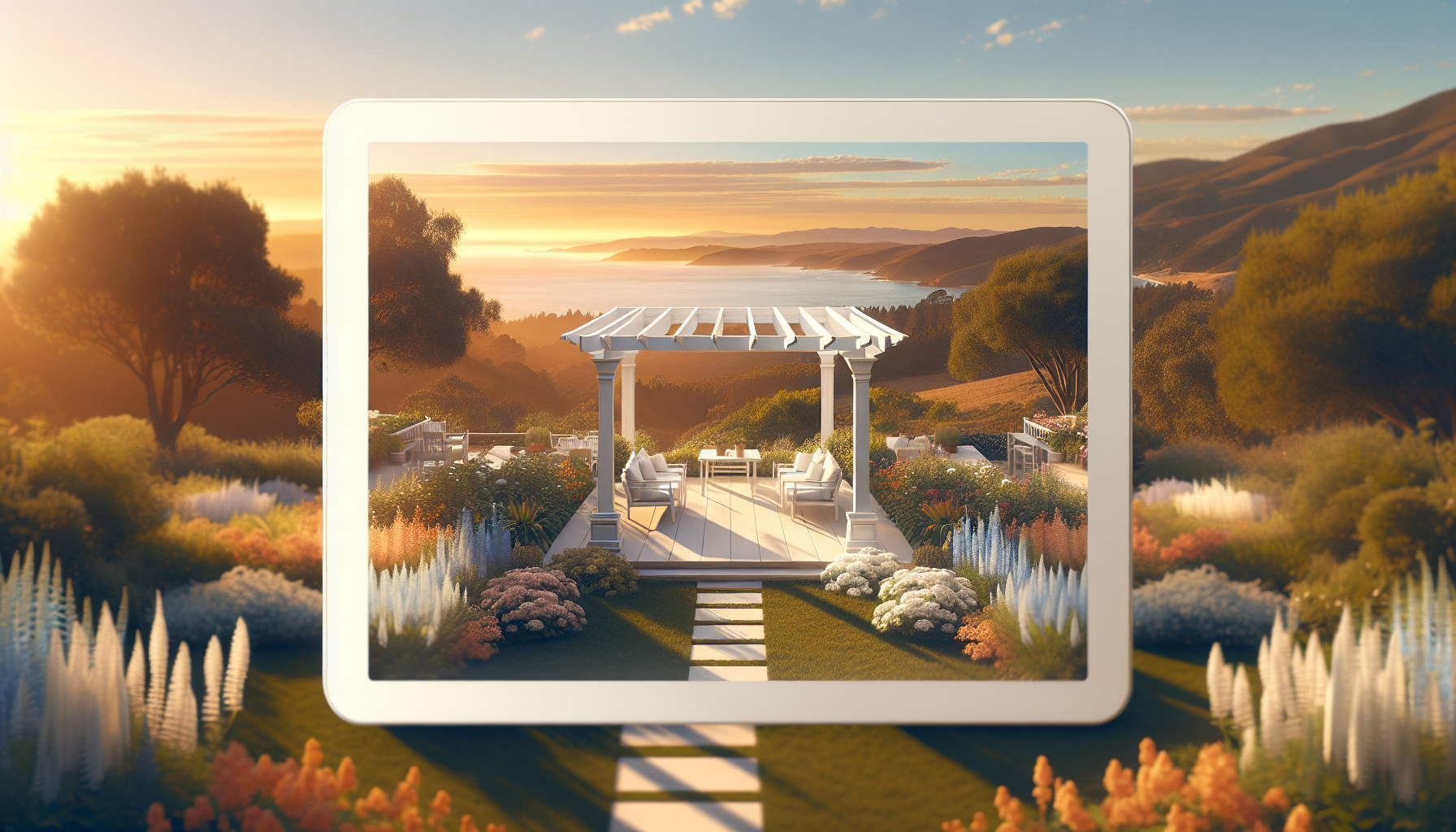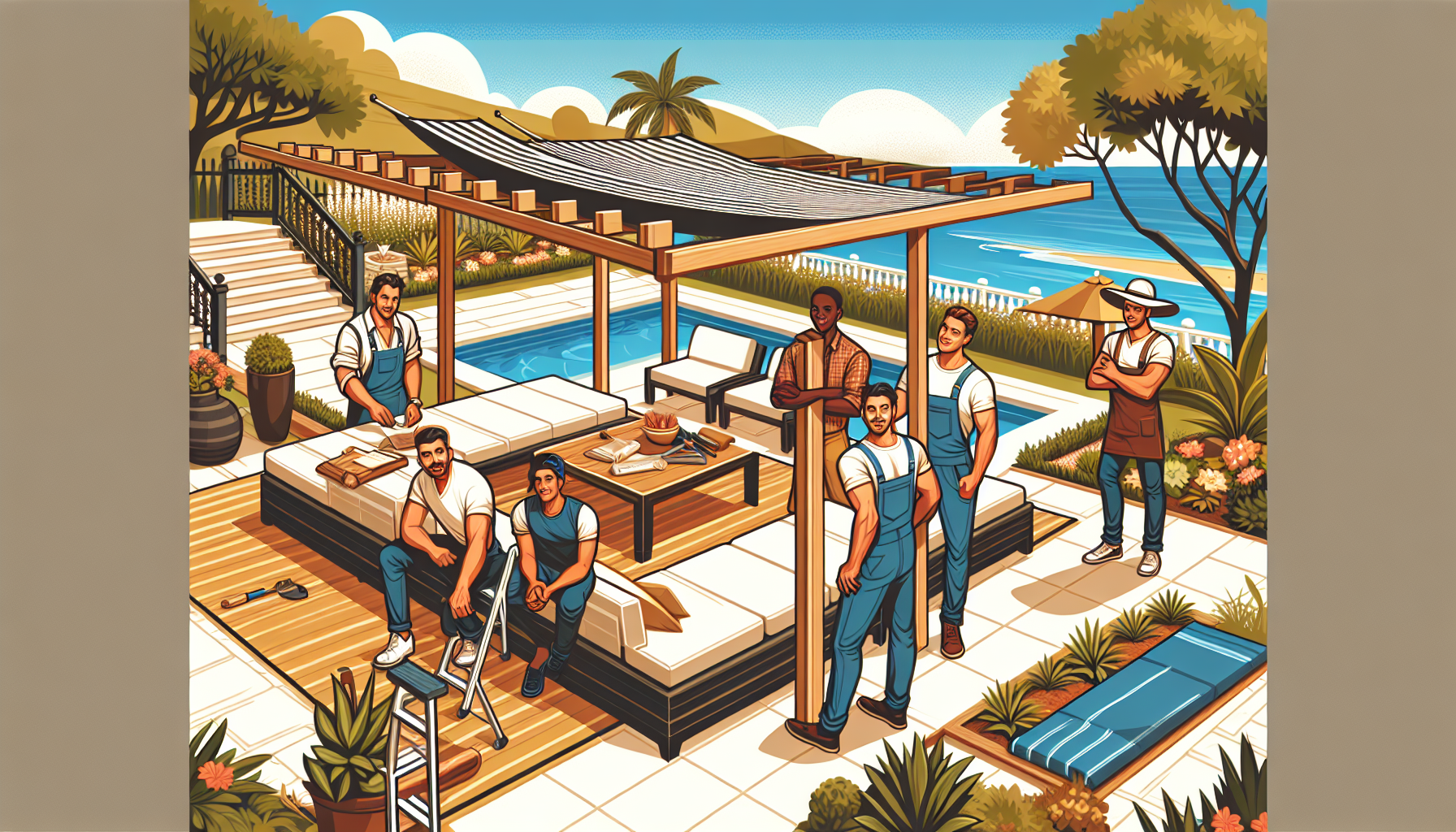What Is a Shaded Pergola and Why You Need One
A shaded pergola is a timeless outdoor structure that adds aesthetic appeal and functional space to your backyard or garden. Essentially, it’s a standing framework, typically made of wood, metal, or vinyl, that features a grid-roof to provide a certain level of shade from the sun. Unlike gazebos with a solid roof, pergolas have a roof structure that allows varying degrees of sunlight to filter through, often softened by climbing plants or a retractable canopy based on your preference.
The shaded area created under a pergola provides a versatile space for many activities. It’s the perfect spot for outdoor dining, a calm reading nook, or even a protected area for children to play. By incorporating drapes or screens, one can also attain additional privacy and protection from the elements. The beauty of a shaded pergola is that it’s not just functional; it also enhances the overall aesthetic of your property, potentially increasing its value. The geometric silhouette amidst the greenery of your garden creates a visual statement that is both classic and contemporary.
Why should you consider adding a shaded pergola to your outdoor space? First and foremost, it’s about extending your living space. An elegantly designed pergola can become a natural extension of your home, blurring the lines between indoor and outdoor living. Moreover, with climate concerns being more prominent than ever, a pergola’s shaded sanctuary offers a cooler area to enjoy the outdoors without the severity of direct sunlight. This means you will likely spend more time outside, enjoying fresh air and natural surroundings, which can benefit your mental and physical health.
Furthermore, a shaded pergola is incredibly adaptable – you can customize it to match your needs and tastes. Whether you opt for a full shade cover, partial latticework, or even a motorized canopy, the choice shapes the ambiance and level of sun exposure. Adorning your pergola with greenery can also help to create a more private, peaceful environment while helping to deflect heat, adding a layer of eco-friendly cooling. With this level of versatility, a shaded pergola becomes not just an architectural feature but a reflection of your lifestyle and a unique, creative expression in your outdoor design.
Choosing the Perfect Shaded Pergola for Your Garden
When transforming your garden into a serene and inviting outdoor living space, selecting the perfect shaded pergola can be exciting and overwhelming. It is crucial to consider the aesthetic appeal, functionality, and durability of your choice. A well-chosen pergola becomes a harmonious extension of your home, creating a seamless transition between indoors and out while providing a respite from the sun’s intense rays.
Materials and design are at the forefront of choosing your garden pergola. Traditional wood pergolas offer a classic look that ages gracefully within your garden setting, blending in with the natural surroundings. For a more modern appeal and minimal maintenance, aluminum or vinyl structures might suit your taste. Consider how the material will weather over time and what maintenance it will require to retain its beauty and structural integrity.
Size and Shape Considerations
The size and shape of your pergola are pivotal to its success as a garden feature. It’s important to scale the pergola according to the size of your garden space. A structure that is too small will lack impact, while one that is too large can overwhelm the area and restrict movement. Rectangular pergolas are most common, but there are also square, circular, and even triangular models that can provide an intriguing focal point.
Functional Elements
While aesthetics are important, the functionality of your shaded pergola should not be overlooked. Consider the sun’s direction throughout the day and the shade you desire. The spacing and size of the rafters and top beams will dictate how much sunlight filters through. Adding a retractable canopy or drapes can offer additional shade and protection, giving you the flexibility to enjoy the sun when desired. Integrating these elements successfully ensures that your pergola is a beautiful addition and a functional one that enhances your outdoor living experience.
Design Ideas to Beautify Your Outdoor Space with a Shaded Pergola
Creating an enchanting and comfortable outdoor area can be both a rewarding undertaking and a significant boost to your home’s visual appeal. When considering the addition of a shaded pergola, imagination is your only limit in achieving a space that not only complements your lifestyle but also captivates the aesthetic allure of your garden or patio. Here are several design ideas to inspire your outdoor transformations.
Integrate Climbing Plants for Natural Charm
One of the most traditional and visually striking methods to beautify a pergola is by integrating climbing plants into the structure. Wisteria, with its cascading blue blossoms, or the classic English ivy create a living tapestry that offers both shade and an organic elegance. As the seasons change, so will the appearance of your pergola, providing an ever-evolving feature in your garden. Climbing roses or grapevines add fragrance and fruit and a sense of romance and abundance to your outdoor retreat.
Enhance Ambiance with Lighting
To extend the usability of your shaded pergola into the evening, consider adding a variety of lighting options. String lights or lanterns can create a magical glow that invites intimate gatherings or peaceful solitude after sunset. For a more permanent solution, installing subtle LED strip lighting along the pergola beams can highlight its architecture and provide a gentle luminescence that doesn’t overpower the night’s natural beauty.
Add Comfort with Stylish Furniture
Your shaded pergola will be a natural gathering spot, so comfort is paramount. Choose weather-resistant furniture that invites relaxation and complements the style of your pergola. A cozy outdoor sofa with plush cushions, a hammock, or a quaint bistro set can turn the space under your pergola into an al fresco living room or dining area. Remember to select fabrics and materials that will endure the elements while maintaining their appearance over time.
In these ways, a shaded pergola can become more than just a structure in your garden—it transforms into a living, breathing extension of your home. Whether you are entertaining guests, enjoying a quiet moment with a book, or simply admiring the beauty of nature, a thoughtfully designed pergola can greatly enhance the enjoyment of your outdoor space.
Step-by-Step Guide to Installing Your Shaded Pergola
A shaded pergola can transform your backyard into a serene outdoor living space. In this step-by-step guide, we’ll walk you through erecting your shaded oasis, ensuring you can enjoy the leisure and comfort of your garden regardless of the elements. Whether you’re a seasoned DIY enthusiast or a novice to home projects, our instructions will provide clarity and direction for a successful pergola installation.
Planning and Preparation
Before diving into the assembly, it’s crucial to meticulously plan and prepare. Begin by choosing the perfect spot in your yard. Consider the sun’s path to maximize shade and ensure the pergola doesn’t interfere with underground utilities. Once you’ve selected a location, measure the area and mark the position where each post will go. Acquire all necessary permits from local authorities to ensure your pergola project meets all building code requirements. Finally, prepare your tools and materials – you’ll need a post-hole digger, concrete, a level, a drill, and the pergola kit with all its components.
Setting the Posts
The strength of your pergola rests on the robustness of the posts. Start by digging holes that are deep enough to support the structure and accommodate frost depth according to your regional climate. Typically, holes should be about 24 to 36 inches deep and 9 to 12 inches in diameter. After placing the posts in the holes, use a level to align them perfectly vertically. Secure the posts by pouring concrete footings, then wait for them to cure fully, which usually takes 24 to 48 hours.
Assembling the Pergola
With the posts set and secured, it’s time to assemble the frame of your shaded pergola. Depending on your pergola design, you’ll either attach beams to the tops of the posts to support the rafters or fit the posts into notches pre-cut into the beams and rafters. When attaching the components, use exterior-grade hardware to ensure longevity. The rafters are typically closer together for shaded pergolas to provide ample shade. Once the basic structure is established, install the top slats (if your design includes them), evenly spacing them across the rafters for consistent shade and appeal.
Maintaining Your Shaded Pergola for Longevity
Maintaining a shaded pergola is essential to ensure it remains a beautiful and functional part of your outdoor space for years. Exposure to the elements can take a toll on the materials, regardless of whether your pergola is made of wood, metal, or vinyl. Regular maintenance can prevent damage such as warping, rotting, rusting, and fading, thereby extending the lifespan of your pergola.
First and foremost, regular cleaning is crucial. Remove any debris, such as leaves or twigs, that has accumulated on the roof or in the corners of the structure. These materials can trap moisture and lead to wood decay or corroded metal. For a wooden pergola, gentle cleaning with soapy water and a soft brush can remove dirt and mildew. If your pergola is metal, check for any signs of rust. This should be treated immediately with a rust-neutralizing product, followed by touch-up paint to protect against further corrosion.
Seasonal Inspection and Treatment
Conducting seasonal inspections is a proactive way to address potential issues before they become major problems. During these inspections, look for signs of wear and tear, such as loose bolts and fasteners, which you should tighten as needed. For wood structures, applying a fresh coat of stain or sealant annually may be necessary to protect against moisture and UV rays. You’ll also want to ensure that any climbing plants or vines are not causing damage or overburdening the structure with excessive weight.
Don’t overlook the area surrounding your pergola. Ensure that you have proper drainage in place to prevent water from pooling around the bases of the posts, which can lead to wood rot or rust. Additionally, if plants are directly adjacent to your pergola, remember to prune them regularly to prevent overgrowth that could contribute to wood decay or dampness issues. By staying vigilant with these maintenance habits, your shaded pergola will remain a durable haven in your garden for many social gatherings and peaceful afternoons.




